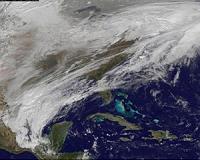 |
Leicester, UK (SPX) Feb 08, 2011 Earth observation scientists at the University of Leicester have recorded stunning images of tropical cyclone Yasi by orbiting satellites. Japanese Meteorological Agency and European Space Agency satellite instruments have been observing the intense storm over Australia from their vantage points in space. University of Leicester scientists have used two instruments, MTSAT-2 and MERIS, which have enabled the scientists to follow the progress of the storm as it headed towards and then struck the Australian coast. They have provided unique views from space of a storm system which is larger than the UK. The newly operational MTSAT-2 images from February 2nd are particularly striking. The images, showing the coldest clouds as white, reveal the extent of swirling white cloud and the deep eye of the storm which is clearly visible just off the coast of Northern Australia. The MERIS images taken on February 1st, shows the cloud system in greater detail (the colour scale runs from white clouds to green vegetation); MERIS on Envisat was recently placed in a new operational orbit to extend its mission lifetime. A movie of MTSAT-2 data shows the rapid approach of the storm and the real strengthening of the cyclone as it nears the coast. Dr David Moore from the University's Space Research Centre in the Department of Physics and Astronomy said "What these images reveal is the sheer scale of tropical cyclone Yasi. This particular storm system has intensified over the past several days into a system larger than the UK. Indeed, the size of the storm's eye is itself larger than the Isle of Anglesey!" Professor John Remedios, Head of Earth Observation Science at the University of Leicester, said, "The strength of the storm and the clarity of the eye are quite remarkable. Satellite systems allow us to monitor and improve the forecast for the areas at risk. They also really show us the immense energy of natural systems which still have a profound effect on our daily lives. In Australia, it really has been a most difficult few months with the combination of a number of intense weather events." The MTSAT-2 is a dual mission satellite for the Ministry of Land, Infrastructure and Transport and the Japan Meteorological Agency and is part of a series of geostationary satellites centred over the Pacific Ocean. The instrument became operational in July 2010 and is capable of measuring over visible and infrared wavelengths in five channels. The MERIS instrument is flown on the European Space Agency (ESA) satellite, Envisat, launched in 2002. The MERIS instrument is able to observe vegetation greenness and ocean colour, and their change over the seasons. The Envisat recently underwent a controlled orbit change to extend its lifetime to 2013. The images show that the instrument is working very well.
Share This Article With Planet Earth
Related Links University of Leicester View a short video showing the approach of the cyclone on YouTube NASA/Goddard Space Flight Center Earth Observation News - Suppiliers, Technology and Application
 GOES-13 Satellite Sees Groundhog's Day On Ice
GOES-13 Satellite Sees Groundhog's Day On IceGreenbelt MD (SPX) Feb 04, 2011 Punxsutawney Phil predicted that spring will come on time, and NASA satellite data suggests that residents in more than one-third of the U.S. are now anxious for the prediction to come true. A massive winter storm touched 30 states over the last couple of days, including Phil's home at Gobbler's Knob in Punxsutawney, Pa. where rain mixed with sleet and freezing rain this morning before it ... read more |
|
| The content herein, unless otherwise known to be public domain, are Copyright 1995-2010 - SpaceDaily. AFP and UPI Wire Stories are copyright Agence France-Presse and United Press International. ESA Portal Reports are copyright European Space Agency. All NASA sourced material is public domain. Additional copyrights may apply in whole or part to other bona fide parties. Advertising does not imply endorsement,agreement or approval of any opinions, statements or information provided by SpaceDaily on any Web page published or hosted by SpaceDaily. Privacy Statement |